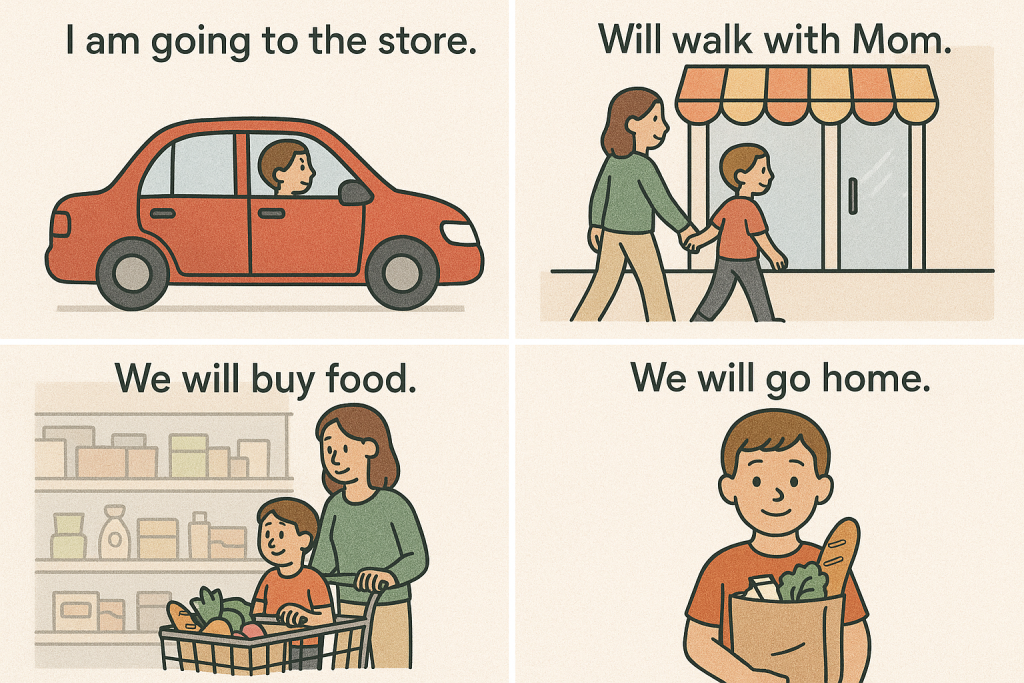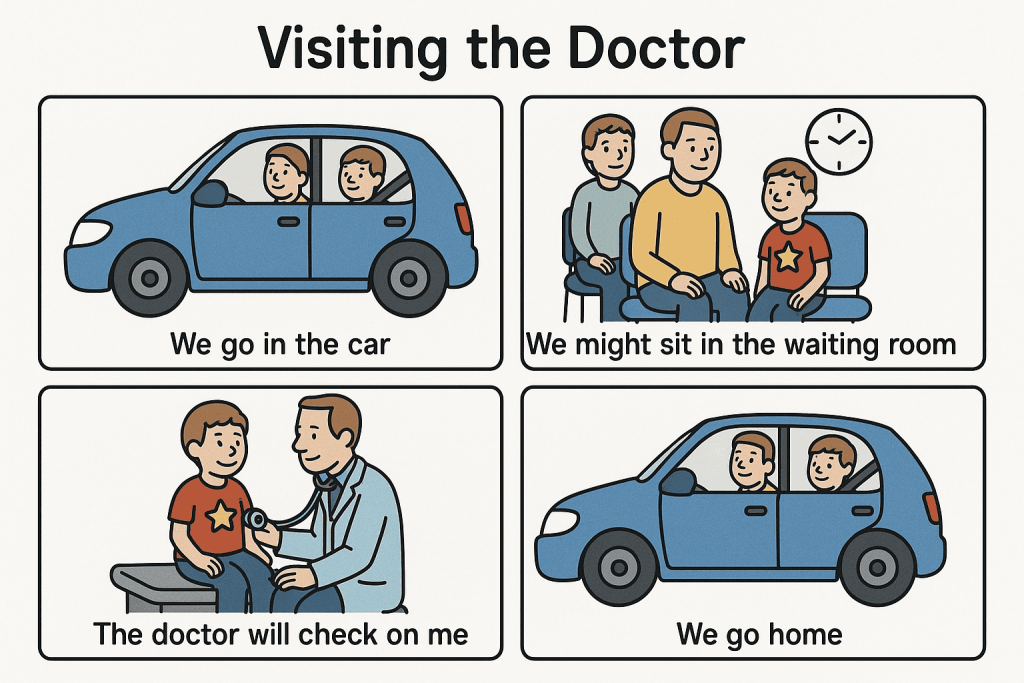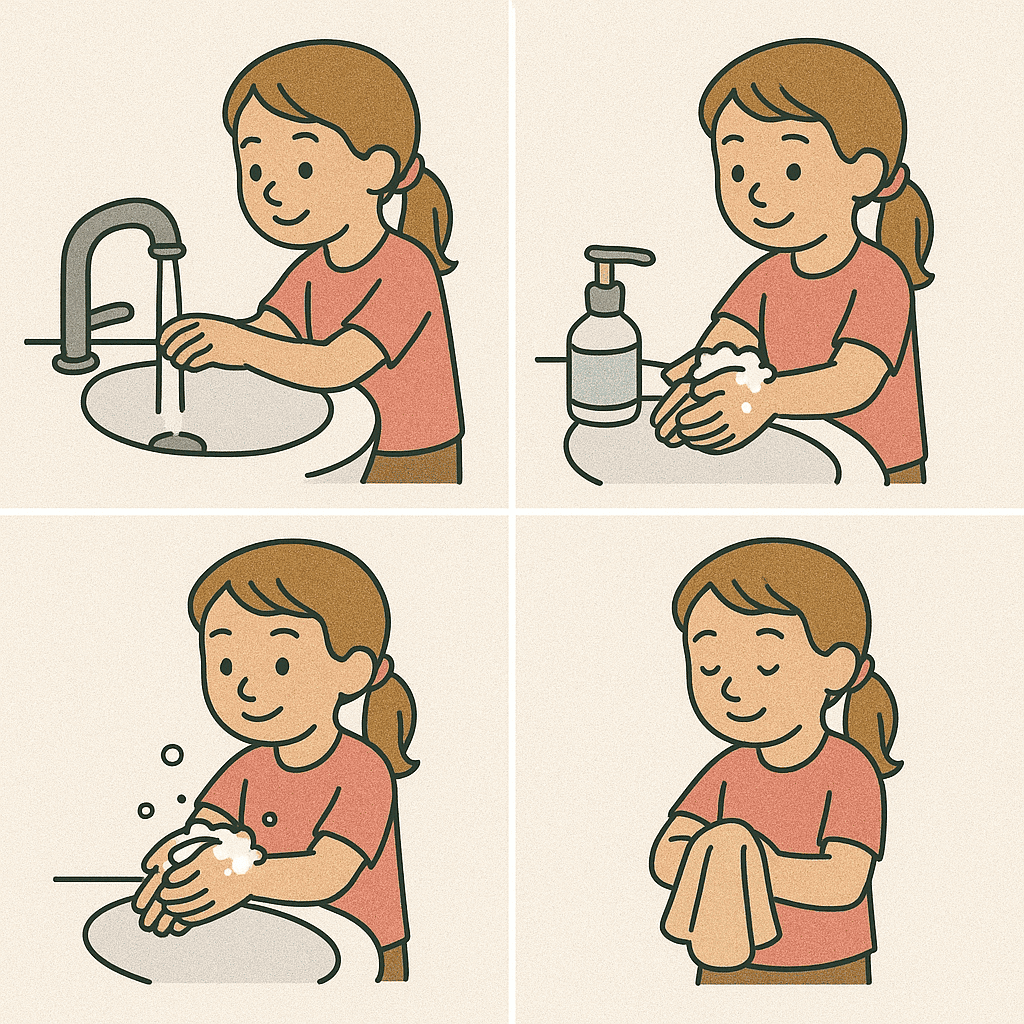Social stories have shown impressive results in supporting communication for autistic children and adults. Whether you are a family member, a carer, or an education assistant, social stories can be an invaluable support in everyday activities. From brushing teeth to enjoying a favourite hobby or making friends, social stories are reliable tools to guide and encourage positive engagement.
When people receive the right support, we see them grow beyond limits.
What Are Social Stories?
Social stories are short, simple stories that explain everyday situations in a clear way. They are written to support autistic children understand what might happen, what they can do, and how people may act in those situations. Social stories use calm, reassuring language so children feel prepared and confident.
Through social stories, autistic children are introduced to social situations and supported in learning how to navigate them.
Example: Going to the Supermarket
Sometimes I go shopping with Mum.
The supermarket can be busy and noisy.
I will stay close to Mum and hold the trolley.
When we pay, we wait in line until it is our turn.
After shopping, we go home.
As the example shows, social stories can help ease distress in unpredictable situations or changes to routine, and they can also be used to explain everyday experiences that have previously caused upset, so that the child feels more prepared and reassured.

Who Developed Social Stories?
Social stories were first developed in 1991 by Carol Gray, a teacher and consultant working with autistic children. She noticed that many children struggled to understand everyday situations and the unwritten rules of social interaction. To support them, she created short, simple stories that explained what was happening and what the child could do.
Carol Gray’s approach quickly gained recognition because it used clear, positive, and reassuring language. Today, social stories are widely used around the world to help autistic children and adults build confidence, understand social cues, and live active lives in the community.
The Purpose of Social Stories
Social stories are designed to support autistic children in developing social skills in a simple and structured way. They can be used to explain what might happen, why it happens, and what the child can do in response. social skills
They are used to:
- Make situations feel more predictable and reduce distress
- Build confidence in handling daily experiences
- Support positive behaviour through clear guidance
- Prepare children for changes in routine or new events
- Guide social interactions in an understandable way
- Provide reassurance in moments that may otherwise feel overwhelming
Example: Visiting the Doctor
Sometimes I go to the doctor.
The doctor helps me stay healthy.
First, we wait in the waiting room.
When it is my turn, we go inside.
The doctor might look in my ears, check my heart, or ask me to open my mouth.
If something feels a little uncomfortable, I can take a deep breath.
After the check-up, we go home.

Why They Are Effective for Autistic Children
Research has shown that social stories can provide valuable support for autistic children by reducing anxiety, strengthening social engagement, and encouraging positive participation in daily life. For example, a randomised controlled trial reported that children who engaged with social stories demonstrated clearer understanding of upcoming events, experienced less distress, and showed lasting improvements in how they managed social situations up to six weeks after the intervention (Chan et al., 2020).
Other reviews highlight that social stories help children prepare for changes in routine, support self-regulation, and enhance communication by presenting information in a structured, predictable, and reassuring way (Karkhaneh et al., 2010; Kokina & Kern, 2010). These findings underline the effectiveness of social stories as a practical, evidence-based approach for supporting autistic children in everyday experiences.
Key Principles for Writing Social Stories
When writing social stories, the way information is presented matters as much as the content itself. Using clear and supportive language-whether in the first or third person-helps children relate to the story.
Carefully chosen descriptive sentences create a picture of what to expect, while affirmative sentences provide reassurance. Directive and perspective sentences then add gentle guidance and show how others might feel in the situation. Together, these approaches make social stories both understandable and meaningful.
Keeping Language Clear and Simple
Social stories work best when the language is straightforward and easy to follow. Short sentences with everyday words help children focus on the message without confusion. Using positive phrasing also makes the story more reassuring and engaging. The aim is to make the meaning clear the first time the child hears or reads it, so they feel prepared and supported.
Example: “I will stay close to my teacher in the playground. This helps me stay safe.”
Using a Positive and Reassuring Tone
A social story should always be written in a way that makes the child feel safe, supported, and confident. Positive wording encourages them to see the situation as something they can manage, while a reassuring tone reduces worry about what might happen. This approach helps build trust in the story and makes it more likely that the child will use it as a helpful guide.
Example: “In the classroom, I can use a quiet voice. This helps everyone learn.”
Understanding the Needs of the Person
Every social story should be tailored to the specific needs of the person it is written for. This means considering their age, communication style, interests, and the situations that may feel challenging. By shaping the story around what is meaningful and relevant to every child, it becomes more engaging and more effective in providing stability and guidance.
Example: “Sometimes I wait, just like a train waits at the station. When it is my turn, I can go, just like the train leaves when the signal is green.”
Step-by-Step Guide to Writing a Social Story
Everyday interactions often involve body language, facial expressions, gestures, and eye contact, which can sometimes be confusing for autistic children. Social stories give parents a way to explain these social situations in a simple and reassuring format that makes sense to their child.
The steps below show how to write a social story.
Identify the Goal or Situation
Start by choosing a clear goal, such as waiting in line or making eye contact. This ensures the story focuses on one challenge at a time.
Example: “Sometimes I wait in line at the shop.”
Break It Down into Clear Steps
Divide the situation into small, predictable steps so the child knows what will happen next.
Example: “First, I stand behind someone. Next, I wait. Then it is my turn.”
Use Directive Sentences
Use directive sentences to give gentle guidance without pressure.
Example: “I can wait quietly until it is my turn.”
Add Visuals and Illustrations
Pair text with photos, drawings, or symbols to make the story easier to understand.
Example: A picture of children waiting in line next to the sentence “I wait in line.”
Adapt The Social Stories for Different Ages
Adjust the format to suit the child’s age and understanding. Younger children may only need picture sequences, while older children benefit from simple sentences with more explanation.
Example:
- Younger child: four-step picture sequence of washing hands.
- Older child: “Washing my hands keeps me healthy and ready for meals.” with a photo or illustration.

Empowering Through Clarity
Social stories empower autistic people by turning confusing or unpredictable experiences into something clear and manageable. Everyday moments-such as joining a game, visiting the doctor, or travelling on the bus-are broken down into simple, reassuring steps. This makes the world feel less overwhelming and gives the person the confidence to take part without fear of what might happen next.
By explaining not just what will happen but also why, social stories create a bridge between the person’s perspective and the expectations of others. This helps build trust and supports emotional regulation. Instead of reacting to uncertainty, autistic people can approach situations with a sense of preparation and control.
In this way, social stories are more than teaching tools-they are a form of empowerment. They give people the knowledge and control needed to navigate daily life with greater independence, dignity, and confidence.
Positive Outcomes with Social Stories and Multimedia at Catalyst Care Group
At Catalyst Care Group, we support autistic people, people with ADHD, mental health needs, and people with learning disabilities through social stories that provide clarity, reassurance, and connection. We combine digital and innovative approaches, ensuring our person-centred, outcome-based approach delivers care that truly makes sense to people’s lives.
By working in partnership with families, local authorities, schools, and community teams, we turn everyday challenges into opportunities for positive outcomes-building communication, confidence, and independence.
- Multimedia tools – using interactive and digital resources (e.g., video avatars, social stories, digital guides) to bring stories to life
- PECS and visual boards – strengthening communication through visual systems
- Objects of reference – offering tangible cues to support transitions and routines (part of our broader visual communication strategies)
- PERMA model of well‑being – promoting positive emotions, meaningful engagement, and relationships
- PACE model of support – building trust through Playful, Accepting, Curious, and Empathetic care
- Positive risk-taking – encouraging independence and personal growth while ensuring safety
- Positive Behaviour Support (PBS) – embedding respectful, strengths-based strategies in daily care
- Trauma-informed care – ensuring safety, trust, and empowerment in every interaction by understanding the person’s experience
If you’re looking for a support tailored to your loved one’s needs and delivered by a compassionate, skilled team, Catalyst Care Group is here to help.
To learn more, get in touch with us or make a referral.
FAQ
Below you’ll find answers to some of the most common questions about social stories.
Can Social Stories be Used for Non-verbal Children?
Yes, social stories can be adapted for non-verbal children by using pictures, symbols, or photos in place of text. Parents and carers can read the story aloud or use visual sequences, so the child understands the situation without needing to rely on words.
How Long Should a Social Story be?
A social story should be short and focused, usually between 5–10 sentences, depending on the child’s age and attention span. The goal is to explain one situation clearly without overwhelming the child with too much information.
Should Social Stories be Read Daily?
Reading a social story daily can help create reassurance and reduce anxiety, especially before the situation occurs. Over time, the story may be used less frequently as the child becomes more confident.













